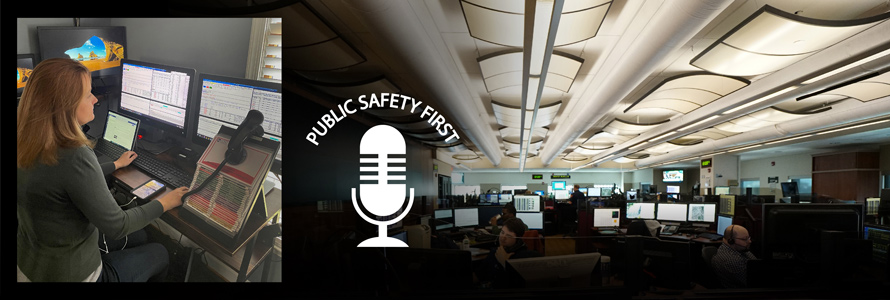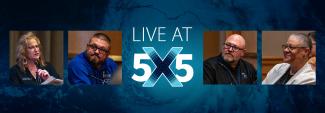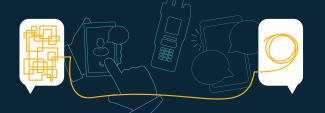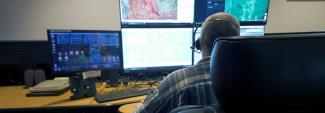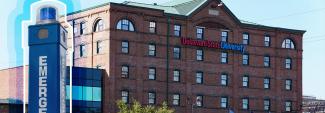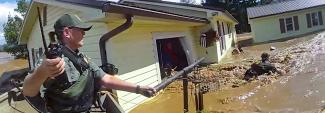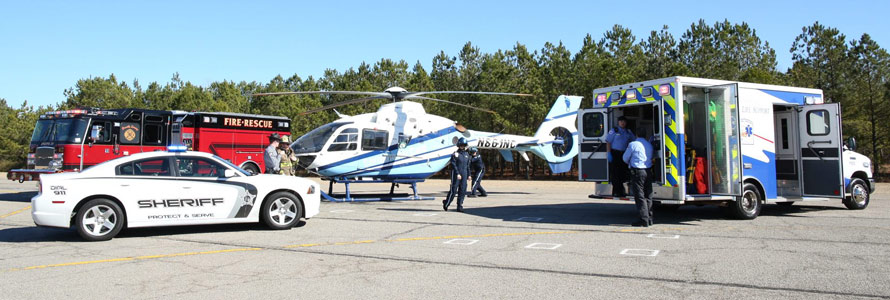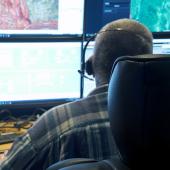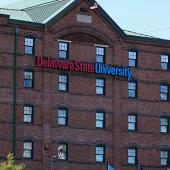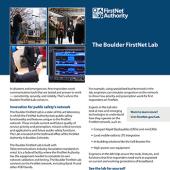Summary
In response to the spread of COVID-19, public safety agencies looked for ways to keep personnel safe while continuing to serve their communities. The Arlington County Emergency Communications Center in Virginia launched remote call-taking, dispatching, and supervision capabilities. Telecommunicators are able to work from home or other locations with a setup that includes a FirstNet hotspot.
Guest
Lori Stone
FirstNet Authority Senior Public Safety Advisor
Dave Mulholland
Director, Arlington County Emergency Communications Center, Virginia
Scott Boggs
Director, Homeland Security and Public Safety, Metropolitan Washington Council of Governments
Transcript
Preview
Narrator: You're listening to Public Safety First, a podcast to help you learn about the First Responder Network Authority and how you can be part of the future of public safety technology.
And now, your host.
Lori Stone: Welcome to the Public Safety First podcast! I’m Lori Stone. I serve as a Senior Public Safety Advisor with the First Responder Network Authority. I’m joined today by Dave Mulholland, Administrator of the Arlington County Emergency Communications Center in Virginia, and Scott Boggs, Managing Director of the Metropolitan Washington Council of Governments’ Department of Homeland Security and Public Safety. Both bring a wealth of experience in public safety and communications in the National Capital Region.
Narrator: You're listening to Public Safety First, a podcast to help you learn about the First Responder Network Authority and how you can be part of the future of public safety technology.
And now, your host.
Lori Stone: Welcome to the Public Safety First podcast! I’m Lori Stone. I serve as a Senior Public Safety Advisor with the First Responder Network Authority. I’m joined today by Dave Mulholland, Administrator of the Arlington County Emergency Communications Center in Virginia, and Scott Boggs, Managing Director of the Metropolitan Washington Council of Governments’ Department of Homeland Security and Public Safety. Both bring a wealth of experience in public safety and communications in the National Capital Region.
On the podcast, we’ll be discussing Arlington’s efforts to launch remote dispatching and remote supervision. They are one of the first ECCs [emergency communications centers] in the nation to pursue these cutting-edge capabilities. We are so pleased that you both could join us today – welcome to the podcast! Dave, let’s start with you – can you tell us a bit about your background and career in public safety?
Dave Mulholland: I'm Dave Mulholland. I have about 33 years in public safety. Twenty-seven years I spent in the federal government, federal law enforcement, retired as a major with the U.S. Park Police. I spent one year as the Statewide Interoperability Coordinator for the District of Columbia, and I have been here since May of 2017 as the Administrator or Director of the Arlington County Emergency Communications Center, or our 9-1-1 center here in Arlington. I also have served in a variety of roles with the Metropolitan Washington Council of Governments [COG]. Currently, I am the co-chair of the COG 9-1-1 Director's Committee and I am chair of the COG Interoperable Communications Regional Programmatic Working Group, which is a crosscutting group of practitioners that focus on dealing with ensuring that we can share information in a seamless and transparent manner despite any circumstance.
Lori Stone: Thank you, Dave.
Scott Boggs: My name is Scott Boggs. I am currently the Director of Homeland Security and Public Safety at Metropolitan Washington Council of Governments. Previously, I spent over 26 years in fire and rescue, also serving in law enforcement roles in 9-1-1 centers as support for the dispatch operations. For the last four years, I've spent coordinating with public safety partners from around the region – law enforcement, fire and rescue, health officials, and many others, including executives at the at the local government level.
Lori Stone: Dave, please tell us what you're doing with Arlington County Emergency Communications Center. This has been something that's been long practiced and dreamed of, and you've made it a reality. Can you walk us through what you're doing?
Dave Mulholland: So, the year 2020 brought us some surprises and it taught us a lot of lessons. The first thing it taught us was that we should be prepared for anything that happens. And we need to be really creative to think about what those things are that could happen. COVID was the first surprise that came to us. Some of the other things weren't necessarily surprises. But we've never envisioned having, for example, a major pandemic, major civil unrest and a major weather incident all occur at the same time. The concern that we had in Arlington was sustainability of our operation. Any one of those instances could create a hardship for our folks, even getting to our brick and mortar center. COVID added the additional hardship of not only people being able to get in, but having people here and keeping them safe and healthy while they're here. So, we had to look to say, “How can we continue an operation where we continue to provide that mission critical service of 9-1-1 services to our community, protecting our first responders, dispatching resources out in a manner that makes sense and is technologically feasible?”
The first no-brainer was to exercise our brand-new capability for remote call taking. So, we rolled that out in early summer with the ability for folks sitting at home to take a 9-1-1 call or a non-emergency call from home. And that really proved to be quite a lifesaver for us. We knew that we needed to take it to the next level, but there was a big element of risk when we went to remote call taking. It was relatively new. Fortunately, there were many other centers, including others around us, that were doing it. So, there was a lot of folks that we could benchmark off of and go in the unknown territory together. Trade notes say, "What worked for you? What didn't work for you?"
If we fast forward to December, we had a situation in our center because of COVID and staffing that presented a challenge to us to have supervision in the center just because of some folks that were out. And we had one employee who actually got really creative. She was on leave because of a family member with COVID. But she said, “Hey, look, I could come in and I could supervise from the backup center.” And, you know, okay, not perfect, but better than no supervisor. That got our wheels turning. If you could supervise in the backup center and, of course, you have the full range of capability there, why couldn't you supervise certain parts of the operation from 30 miles down the road or wherever? So, we started to put some thought to that. And as soon as we went to remote call taking, we started having the conversation about being able to dispatch from home as well. There are challenges to that. I would say the primary challenge is, nobody else has really done that. So, there's nobody to compare notes with. There's no best practices. There's no lessons learned. How do you do it? There's a lot of questions. And so, we weren't going to let the questions keep us back. And we made a conscious decision that we would do both remote dispatch and remote supervision at the same time. We did it only from the fire side with a very successful rollout when we did that. And again, what this does is it provides us a continuity of operations despite circumstances. So, when we saw civil unrest start to pick up, we're able to have folks from home log in, whereas they might have had a two-hour delay just to get into work. They're instantaneously available for us to support the mission.
Lori Stone: So, that’s interesting. You mentioned that you have only rolled out remote dispatch and supervision for the fire side at this point. What was the reason?
Dave Mulholland: Yeah, great question of why did we only limit it to fire dispatch? And to be quite honest with you, it's the challenges of law enforcement dispatch, the primary one being there are some significant security requirements that go with our ability to access criminal information networks. So, in Virginia it’s the Virginia Criminal Information Network. There are CJIS security requirements at a federal level that guide the state requirements and then there's additional state requirements. It is a very restricted environment in which you can access that information.
So, we just thought that inherently fire dispatch, fire-EMS, dispatch, that was the place to start. That's what made sense to us because of the structure, because there is less restrictions.
Lori Stone: Well, this is certainly trailblazing technology – your center is one of the first in the nation to launch these capabilities. How did you roll it out safely for dispatchers and the first responders they support?
Dave Mulholland: So, what I will tell you is when we rolled out remote supervision and remote dispatch, we did so with a safety net.
First of all, we clearly communicated with our fire department. We let them know, "Hey, this is what we're going to do." And, you know, there's a little bit of angst with that. But we offset that angst by saying, here's the safety net. There will be a dispatcher sitting live in the center as if they are the dispatcher for that talk group, just in case if, for whatever reason, the person at home disconnects, that person that's there live will automatically jump in. So, what I could say is probably for the first 30 or 60, 90 days as we remote dispatch, we will always have that secondary live safety net person in there. At some point we will have a comfort level that the technology is sufficient. Everything works well and will fall back on saying, okay, so if something does happen, we know we have at least one other fire dispatcher sitting there.
Just like COVID made us rethink how we do our work from a technical standpoint, this is also now forcing us to think, rethink how we do our work from the operational standpoint. It's also starting to force a conversation to say what services are absolutely one hundred percent critical to the mission? So, we would say probably more so in remote supervision, that's a doomsday scenario type of use for us. Right? Our preference is to have our supervisor sitting in the center. But now we know that if something happens that takes out our ability to have a supervisor sitting in here, we can still deliver that service.
Lori Stone: So, David, let's talk about getting there. Can you walk us through what you had to have in place?
Dave Mulholland: I will tell you that different centers have had different approaches. We were fortunate enough in Arlington to be able to execute an approach that said we wanted our call takers and our dispatchers to have almost exactly the same experience in their house that they have in the center. So, I realized that's budget driven. That's money driven, because to do this is not cheap. With our most recently outfitted capability, which includes the ability to take calls and dispatch, you're talking about seven computing devices that are in a person's home. Now, let's call this beta, right. We hope that at some point in time it's not seven and we can start to combine some of those devices and maybe get it down to three or four devices. Those seven devices constitute about eight screens that are in their house. That's a lot of technology that's sitting in there, right. So, what do they have? They have a full-blown VESTA remote capability. They have full blown access to our computer aided dispatch [CAD]. We do accomplish that today through the use of remote desktop. So, they are actually connecting into a vacant seat in the center. Fortunately, when we built our center years ago, we, we future-proofed it with a lot of vacant seats. So, that's not an issue, but it's something the supervisor needs to be aware of. If somebody comes in and wants to sit down, "No, you can't sit there because someone's actually remote into that."
I'm not a big believer in remote desktop. It has challenges. So, our next iteration of CAD will be a, a hybrid in-the-cloud solution with some type of local client that allows them access if you lose connectivity with the mothership. But the ability to connect to your, your CAD from any place at any time is key. But they are doing remote connection in to the CAD. They have resource computers for the supervisors and call takers that live outside of our land mobile radio system reach, which is most of our employees. They operate off of Motorola Wave so they can monitor. That is not dispatch. We'll get to dispatch in a second. That's just for those that only need to hear what's going on in the radio. We have a mobile data computer for their access to Viscid and then we use the Motorola MCC 7500E as the remote dispatch. So, this was huge and again, significant investment in both the VESTA piece and there and the remote dispatch piece. All told, we're probably talking about $90,000 worth of technology per deployment. Not cheap to do, but at the end of the day, if that's the only way you can deliver service, the value of that 90,000 is well, well paid back.
So, now how do we connect? Because there's a lot of pieces there. The initial connection for our people at home is their home network. So, there's some things for us to think through in that, right? Like how do we ensure that they continuously get good service? We're looking at a couple of different business models for that. We do, when we decide who gets these devices, make sure that they have a robust home network. We're looking for a cable carrier that's giving them a couple of hundred megabits per second or a fiber optic carrier that's going to give them that. But we know that it doesn't take much for a home network to get clogged. And when we were testing for remote call taking, what we found is folks who have kids that are on streaming movies or playing video games or something could have an impact. So, for continuity of operations, they also work off of up to two MiFi devices, or wireless hot, cellular wireless hotspots. We look at where they live because, again, we have people that live up to 75 or more miles away from here and they may be in more rural areas. And we look at the two cellular carriers that provide the best coverage. Almost all of our folks have an AT&T FirstNet hot spot device in their house, and then they also have whichever the other strongest carrier is, and we have them from time to time log in that way just to make sure of one, they're used to it, and two, that, that it still provides a service that needs to be provided.
So, when we did our debut of the remote dispatch in the first half of the session that we did, our dispatcher was logged on by home network and then at the halfway point, logged off and then logged on using the AT&T FirstNet device and found that there was no issues using either one of those devices. So, the ability to connect is huge. We are looking at routers which would allow us to put multiple SIM chips in and the home network, which would have an automatic failover or look to say not just the failover, but look to say what's providing the most robust network. And I'm going to seamlessly move you over to that. That's in our next phase.
Lori Stone: So, it sounds like you've done a whole lot of testing, a whole lot of preparation, did you do this work with your center employees or did you hire any outside consultants? Like how is your team built to do all this kind of work?
Dave Mulholland: What we've done has been accomplished by an incredible team of people that are here. I will say that from the technical side, we were very cautious when we went into remote call taking. With remote supervision and remote dispatching, we just dove right into the pool. And again, I'll go back to what I said earlier. No one's done this before, really. There was no best practice document. There was no lessons learned. There was no, "Hey, who can I pick up a phone and talk to you that maybe can give me some ideas?" And what we decided to do was to do it with those safety nets in place. We recorded the sessions and what that allowed for was in between the dispatch calls, the conversation as our dispatcher was going, "Man, never even thought about this, but we need to make sure that the CAD can do this. Wow. I never realized that I need to make sure that I need to turn this on." And I think out of a one-hour session that we did, we came up with a better list of what do we need to do next time and how do we need to build out this infrastructure than if we had sat in a room for a week and said, "Hey, how should we do this?" So, you know, this is, this is the way it works in life. Someone's got to step out. Someone's got to do something so that the other folks can learn. We learned from other folks that were doing remote call taking. Now, we think it's our turn to, to reach back and to help other people. We do have a consultant that works for us, but he is not guiding the deployment of the technology. He is the one who's collecting all our lessons learned, best practices document. We're getting ready to release about a 35-page lessons learned, best practice document on remote call taking. He's also building our strategy of what are the steps that we need to take so that we get to the ability to take calls remotely, dispatch remotely, supervise remotely, business as usual down the road?
Lori Stone: So, I liked how you referred to using FirstNet in the COOP mind frame of having it there, always running in the background when needed, able to provide that communications link that you feel that you have to have. Can you envision it ever being the forefront, being that connection you use day-in, day-out all the time for these capabilities?
Dave Mulholland: The use of FirstNet is really going to be driven by the bandwidth that is provided at the call taker, dispatcher, or supervisor's home. As I mentioned, we have six to seven computing devices that are all connected and running off of this. Motorola, whether it's through the MCC 7500E or VESTA, do have certain bandwidth requirements. One of the things that we have found more on the VESTA side is that voice traffic is very sensitive to jitter. And so, we have found that when we're on cellular connection, it's not unusual to see us drop a call. We are obviously working to see if there's solutions around that. But I think as the infrastructure grows for FirstNet, as capability grows, certainly there could be a time when we say this would be the go to. But that said, I want to emphasize that the value for FirstNet will be if the circumstances are dire, if this truly is the “we just went right of boom” scenario, there's a significant likelihood that the traditional communications channels are not going to be effective. So, it's not just the everyday business as usual. This is the “hey, we do have a significant incident or event that just happened and everybody's on the internet. And what I need to know is I'm not going to get kicked off the internet. That's the peace of mind that it brings to me, because the biggest objection that we have heard from any of our stakeholders or other folks that we've engaged in discussions about remote capabilities is this is life and death. And you've got to make sure that you remain connected. And the reality of it is, even when I'm in my brick and mortar, I don't have that assurance. There are still single points of failure. So, the reality of it is, let's know what our points of weaknesses are. Let's manage them and let's put in every precautionary level that we can. What we see is that peace of mind that the FirstNet device brings to say, hey, doesn't matter what's going on in the rest of the connected world, we know we are going to have a reasonable level of connection and protection to maintain that connection.
Lori Stone: Thank you. Scott, I'm going to turn to you for a minute. You've had a long career in public safety and you've seen how mutual aid can make a difference in this Northern Virginia, Maryland, D.C. region. What do you think these remote call taking, dispatching, and supervision capabilities that Arlington's doing and then, Alexandria we know is doing it, what does that bring, then, to the entire landscape in the NCR [National Capital Region] and how do you move that forward?
Scott Boggs: So, I'll start off with, you know, if we were talking about private business, we would see what's happened to us in the last 12 months as a disruptor, something that we would not have foreseen, couldn't, could not have evaluated the impacts of, and as a result, we had to depend on leaders like Dave and others in the region to step up and say, how are we going to manage our resilience in an environment that we couldn't even have foreseen? You know, this happened 40 years ago when the Air Florida plane crashed into the Potomac. And we had to figure out as a region how to communicate with each other better. As a result, interoperability became a priority. Again, it happened on 9/11 when we thought we had a lot of things taken care of with respect to communications. But we, we had some, some gaps laid bare as a result of that, and interoperability and connectivity became a priority again. And over the last year, we've had to identify ways to become more resilient, but also consider that we could have a 9-1-1 center not taken down by even an attack or a disruption in communication, but a sheer lack of staffing. And that has brought on opportunities that Alexandria and Arlington have taken on that will provide not just resilience for them, but the ability to potentially, as Dave mentioned earlier, stand up a capability to potentially handle calls for service from other jurisdictions. Because now at a moment's notice, he can stand up more capacity in Arlington and be able to potentially help his neighbors out through mutual aid. That is, is probably the primary next step, especially as we move forward with the buildout of FirstNet as well as Next Gen 9-1-1, cloud computing solutions that we would have never considered for 9-1-1 operations, they have to be our next option in order to build out that type of resilience and capability to support each other across the region.
Lori Stone: Great answer. Dave, anything to add to that?
Dave Mulholland: There's two things I would like to add to what Scott just said. You know, one of the things, one of the flags that we've flown about Next Generation 9-1-1 is this ability that we can reroute calls. So, if, if I'm getting inundated, call overflow, can go to one of my other jurisdictions or vice versa, or if something completely takes out my center, there are other jurisdictions that can handle those calls for me. And that's great. What we're trying to come to grips with in the NCR is, okay, so how do you really make that happen, right? That's nice to say. But when we use different sets of protocols and different sets of rules and sometimes even different nomenclature, those are the pieces that are a little bit challenging. But we're working on that. We actually have working groups that are addressing that right now. So, think about the fact that once we get that solved, and we actually have another initiative called No Call Transfer, that says if you were to dial 9-1-1 by a cell phone and you land in the wrong call center, that instead, when I get that call, I can drop it straight into the CAD of the jurisdiction that needs to respond and save time. So, what we've done with the ability to work from home is make that capability exponentially effective, because that's my next concern. Fairfax County may crash. I'm lucky if I can answer the calls I need to answer in my center. So, what's the realistic expectation that I'm going to pick up their calls? But if I know I can send a page out and say I need 15 call takers to log in from home and take this, this becomes a powerful tool. So, that's a side benefit to my fellow centers around me.
The second piece that I want to add that's a side benefit is recruiting and retention for 9-1-1 centers is challenging. It's especially challenging in the National Capital Region where it's not necessarily cheap to live. So now, if I say two years from now, come be a call taker or a dispatcher for Arlington County, but you could live in Gettysburg, Pennsylvania, maybe you got to come to the mothership once every two weeks and touch base because there are certain skill sets we need you to keep up with and do. But this becomes an incredible recruiting tool, hiring and retention tool for our folks.
Lori Stone: Dave, one last question for you. Can you share what your experience has been with the FirstNet Authority and what benefits you see from the public-private partnership with AT&T?
Dave Mulholland: I really appreciate what you guys bring in. You know, AT&T is a solution provider. And they are business driven. And that's the way they look at things. The unmistakable value of FirstNet is you guys.
Another critical component of being able to deliver services is that assurance to know that we have a good working relationship with the people that are helping us provide those services. And that's the value that FirstNet brings to us, is in working with the actual solution provider of AT&T FirstNet, we know that we have an incredible advocate for us in the FirstNet Authority. It is a government entity that has the ability to leverage its position and be that influencer back to AT&T FirstNet that we could never be. With other carriers, we can let our voice be heard and that's the extent of it. What we have with FirstNet Authority is folks who we know are not business driven. It's not about the dollar. It's about making sure that the needs of the first responders and those who support them are met.
Lori Stone: Perfect. Thank you. Scott, can I ask you the same question?
Scott Boggs: You know, I got to tell you that if you asked me 10 years ago, we would be using cellular services to provide mission-critical data, I would have said it, I don't see a path to that. But because of FirstNet and the FirstNet Authority, we've been able, in the National Capital Region, to directly build relationships from the ground up. We were in communication with FirstNet staff, including Lori Stone and started to express not only what our needs were, but also understand what the vision of FirstNet was. And as a result, now we have a much better confidence that we're really, truly becoming a part of a mission critical cellular data network.
Lori Stone: Well, gentlemen, thank you again so much. we're just very grateful for you spending the time with us.
Narrator: Thanks for listening today. We're excited to have you join our podcast community. Make sure to subscribe on iTunes, SoundCloud, and YouTube. You can learn more about the First Responder Network Authority at FirstNet.gov and learn about FirstNet products and services at FirstNet.com.


